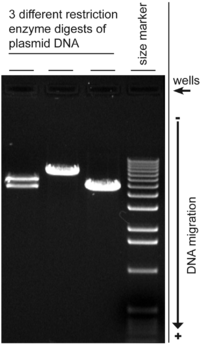
Photo from wikipedia
Abstract Aerosol samples were collected by a MOUDI cascade impactor in central Budapest in winter 2017, and were analysed by GC–MS and AAS methods for major monosaccharide anhydrides, i.e. levoglucosan… Click to show full abstract
Abstract Aerosol samples were collected by a MOUDI cascade impactor in central Budapest in winter 2017, and were analysed by GC–MS and AAS methods for major monosaccharide anhydrides, i.e. levoglucosan (LVG), mannosan (MAN) and galactosan (GAN), and for K, which are important chemical markers for biomass burning (BB) emissions. Their median atmospheric concentrations were 0.36 μg m−3, 37 ng m−3, 10.9 ng m−3 and 0.32 μg m−3, respectively. Detailed mass size distributions were determined in an aerodynamic diameter range of 0.053–9.9 μm for all markers. There were 3 modes identified in the distributions of the monosaccharide anhydrides with typical mass median aerodynamic diameters (MMADs) and relative modal concentrations (RMCs) of 0.42 μm and 90%, 1.62 μm and up to 9%, and 0.11 μm and up to 9%, respectively. The modes were assigned to the condensation and droplet submodes (formed by splitting) of a dominant accumulation mode and to a minor accumulation mode, respectively. The former 2 modes were generated by BB, while the latter mode was explained by another source type with higher burning temperature than BB, which is likely lignite combustion. The size distributions of K also contained 3 modes with mean MMADs and RMCs of 0.40 μm and 78%, 0.16 μm and 12%, and 5.8 μm and 10%, respectively. The former 2 modes were assigned to a major and a minor accumulation mode similarly to the monosaccharide anhydrides, while the latter peak is a coarse mode. Levoglucosan was further utilised to estimate the PM10 mass originating from BB, which yielded a mean relative contribution of 18%. This implies that BB represents a considerable or substantial source for particulate mass in the area. Concentration ratios among the monosaccharide anhydrides suggested that it is the wood burning that is the major form of BB, and that the relative share of softwood burnt to hardwood is around 46%.
Journal Title: Atmospheric Research
Year Published: 2019
Link to full text (if available)
Share on Social Media: Sign Up to like & get
recommendations!